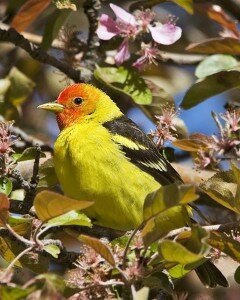
International Migratory Bird Day is a reminder of the serious threats that face the world's birds - and the critical role that refuges play in protecting them. (Image: Western tanager, John Eriksson)
Ever since President Theodore Roosevelt established the very first national wildife refuge in 1903 to protect pelicans at Pelican Island, Florida, refuges have been critical to birds. From hundreds of thousands of neotropical migrant songbirds that rest and feed at refuges along the major flyways, to shorebirds and waterfowl that depend on coastal refuges on the Atlantic, Pacific, and Gulf of Mexico shorelines, our National Wildlife Refuge System is key to the survival of much of the planet’s bird life.
On Saturday, May 14, we celebrated International Migratory Bird Day. And it WAS a celebration, with refuges around the nation organizing a host of bird-related activities that include bird counts, banding demonstrations, children’s activities, educational bird walks and other events.
But the day was also a reminder of the serious threats facing the world’s birds—and the critical role refuges play in protecting them. Habitat is disappearing at an alarming rate due to development, deforestation, and urban sprawl. A changing climate is causing sea levels to rise and critical coastal ecosystems to change and even disappear. Our National Wildlife Refuge System is more important to birds than ever before.
So what can we do to better protect our refuges and the birds that depend on them? At the national policy level, President Obama has taken an important step by pledging full funding for the Land and Water Conservation Fund (LWCF), the chief funding tool available to acquire critical refuge lands. The LWCF uses no taxpayer dollars; it is funded completely by royalties paid to the government from offshore oil and gas leases. The fund was set up to spend up to $900 million annually for land acquisition, yet has rarely been fully funded by Congress. The President’s pledge to provide full funding acknowledges the importance of LWCF in stemming habitat loss and bolstering refuge ecosystems, and that’s good for the birds.
As individuals, we also can make choices that help bird conservation. We can keep domestic cats indoors. The American Bird Conservancy estimates that nearly two-thirds of the 77 million domestic cats in the U.S. are allowed outside, where they kill hundreds of millions of wild birds each year. These include endangered piping plovers, Florida scrub jays, and California least terns. We can choose shade-grown coffee that protects the critical multi-story rainforest ecosystems in Central and South America that provide habitat for neotropical migrants. And, whether or not we use our nation’s wildlife refuges for hunting and fishing, we can all buy Duck Stamps. Duck Stamps are used to purchase more habitat for the Refuge System, and more habitat means more birds for all of us to enjoy.
Evan Hirsche, President, National Wildlife Refuge Association





1 Comment in this post »
RSS feed for comments on this post. | TrackBack URL
Great comments, Evan! I think stressing LWCF is also timely and needed. And earlier this month, the new “State of the Birds” report was released with this year’s theme being the vital role of public lands and waters in bird conservation. You can view that report here:
http://www.stateofthebirds.org/State%20of%20the%20Birds%202011.pdf